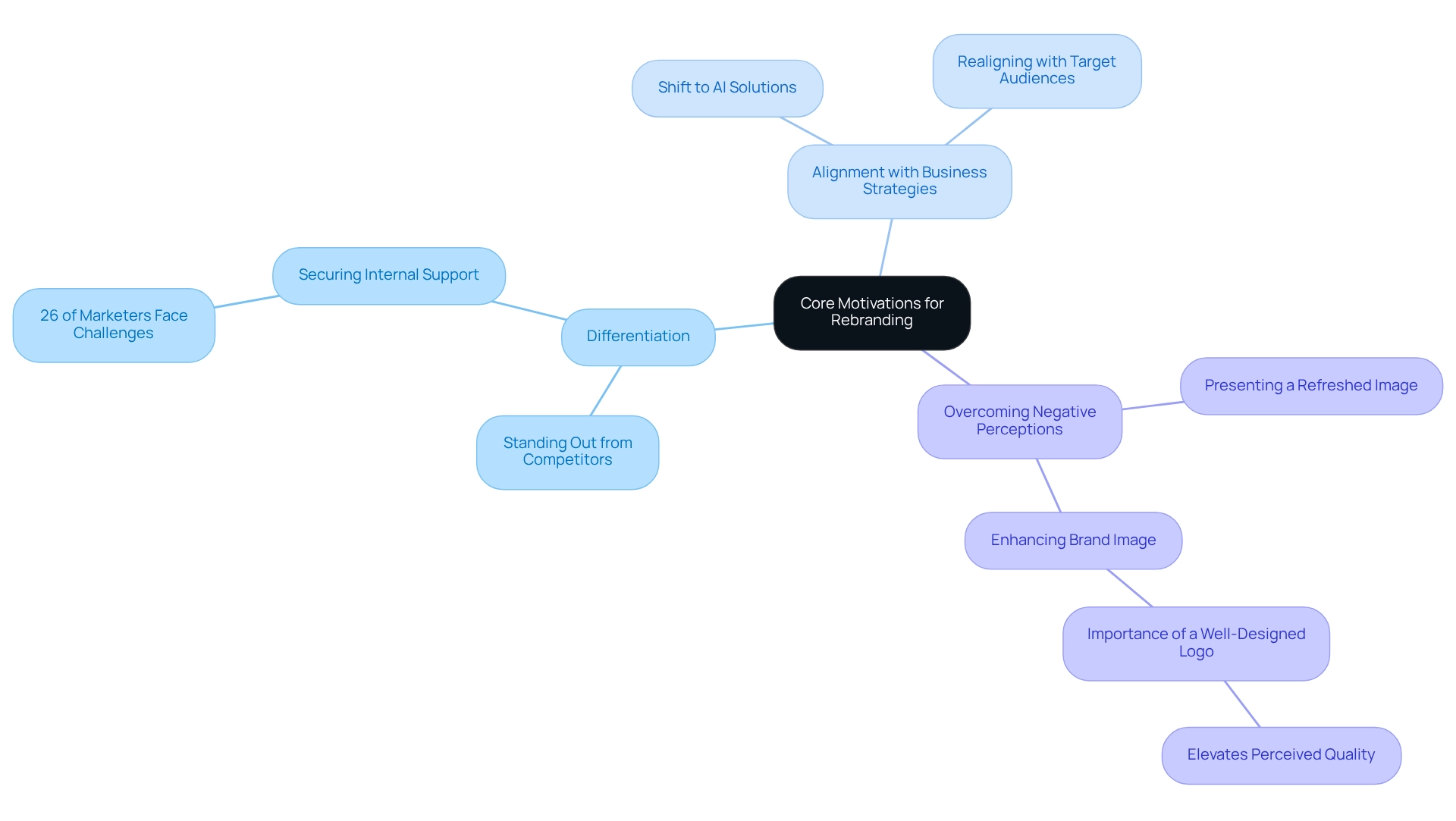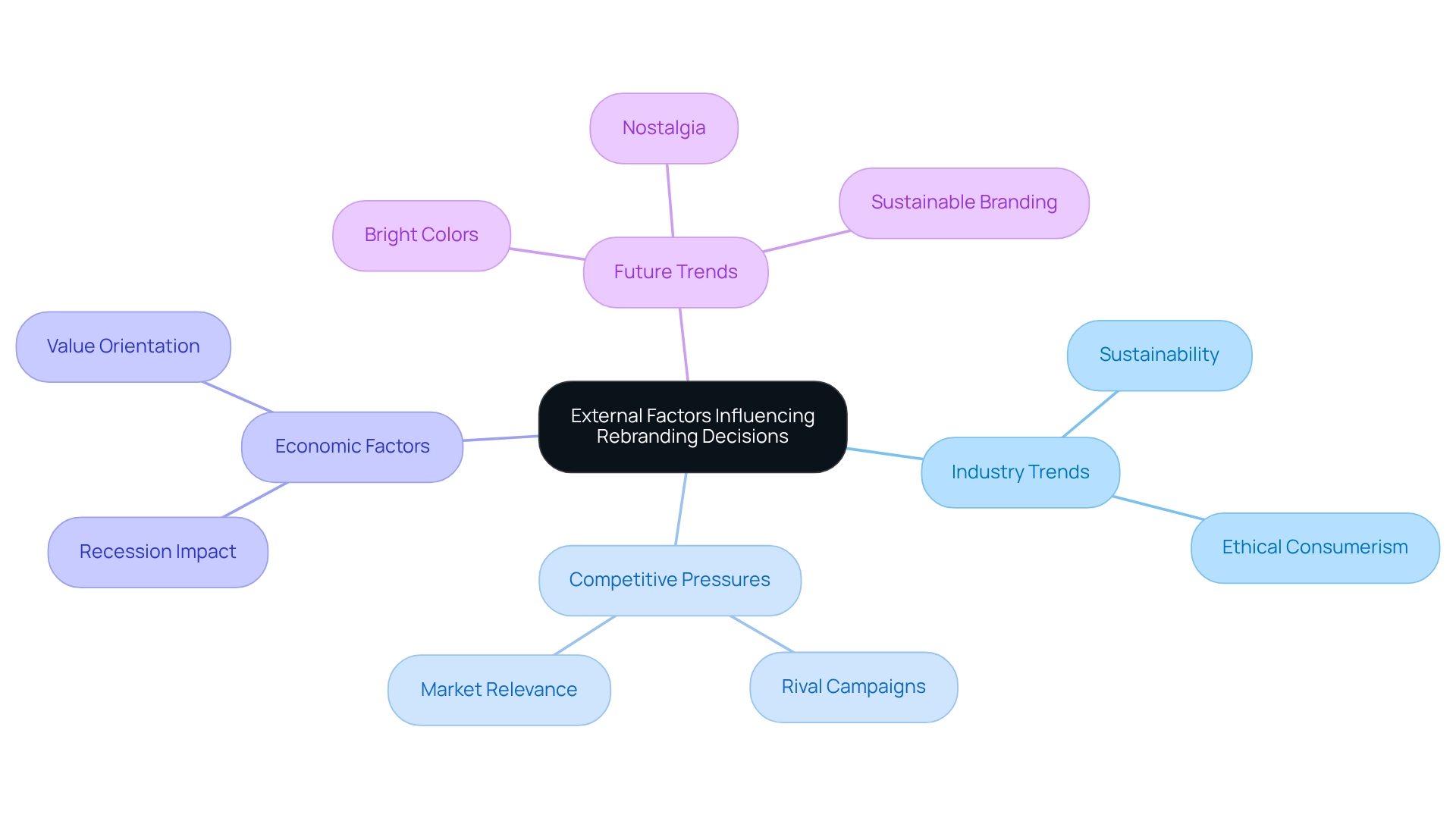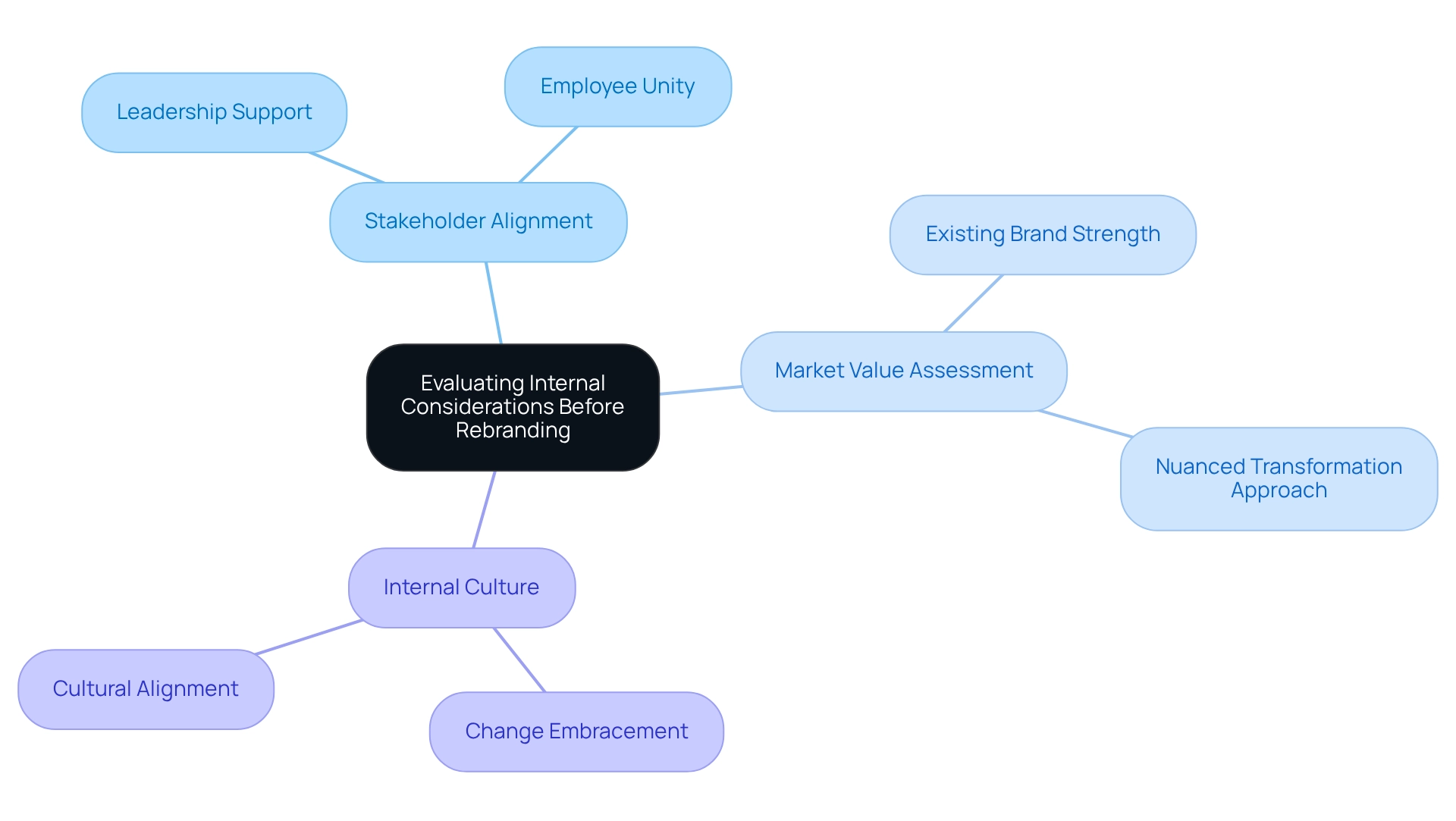Overview
In the fast-paced world of business, companies often find themselves at a crossroads, facing the challenge of standing out in a competitive market. This need to differentiate can stem from negative perceptions that linger in the minds of consumers. It’s a common struggle, one that many organizations grapple with as they seek to realign with evolving business strategies. The implications of this challenge can weigh heavily, affecting not just the company’s image, but also its internal dynamics and stakeholder morale.
However, there is hope. By embracing the journey of rebranding, companies can cultivate a unique identity that resonates with both internal teams and external audiences. This transformation is not merely a cosmetic change; it’s an opportunity to align values and vision, ensuring that every aspect of the business reflects a renewed commitment to excellence. When a company takes this step, it not only addresses market pressures but also enhances its relevance and appeal to consumers.
As you navigate this process, remember that you are not alone. Many have walked this path and emerged stronger, more cohesive, and better positioned to connect with their audience. Embracing change can lead to profound growth, both for the company and its people. Together, we can explore the possibilities of rebranding, fostering a supportive environment that champions your unique story and vision.
Introduction
In today's fast-paced marketplace, many companies face the urgent challenge of redefining their identities. This need for rebranding is not just a trend; it is a heartfelt response to the pressures of standing out in a sea of fierce competition and aligning with the evolving values of consumers. As businesses navigate these complexities, it becomes crucial to understand the motivations behind rebranding—whether it's addressing negative perceptions, adapting to new market trends, or enhancing brand equity.
This article invites you to explore the core motivations, external influences, internal considerations, and the anticipated benefits of rebranding. Together, we will uncover how companies can successfully transition and thrive in an ever-changing landscape, fostering a sense of community and support along the way.
Understanding the Core Motivations for Rebranding
Rebranding often stems from deep-seated motivations that reflect a company’s need to grow and adapt to the ever-changing market landscape. One significant challenge many face is the necessity to stand out from competitors. In a bustling marketplace, brands risk their identities becoming muddled, prompting the decision to be rebranded in order to establish a unique presence. It’s worth noting that 26% of marketers find it difficult to secure internal support for rebranding efforts, highlighting the complexities of this journey.
Moreover, organizations frequently choose to realign their branding with new business strategies or target audiences. For instance, a tech startup rebranded from consumer electronics to AI solutions may find that this change is essential to effectively convey its strategic shift. This transition not only clarifies the company’s new path but also connects with a more relevant audience, fostering a sense of belonging.
Rebranding can also be a strategic response when a company has rebranded due to past challenges or negative perceptions. It provides an opportunity for companies to distance themselves from previous issues and present a refreshed image to their consumers. A thoughtfully executed brand overhaul can significantly enhance ; industry experts often stress the value of a well-crafted logo as a vital component of a broader brand transformation initiative.
Examples of successful brand transformations are abundant, especially among tech startups transitioning to AI solutions. These companies often leverage brand transformation to signal innovation and adaptability, which in turn helps rebuild customer trust and engagement. Ultimately, the motivations behind rebranding a brand are diverse, encompassing the need for differentiation, alignment with evolving business objectives, and the aspiration to overcome negative perceptions. These elements are essential for thriving in today’s dynamic business environment.
In conclusion, understanding the fundamental reasons for altering a company’s identity is crucial for tech startups navigating the complexities of the industry. This knowledge can empower them to establish a strong and relevant presence, fostering a supportive community around their brand.

Identifying External Factors Influencing Rebranding Decisions
External influences significantly affect identity transformation choices, with industry trends like sustainability and ethical consumerism urging companies to reshape their personas. Many conventional food companies are now reimagining their images to highlight organic ingredients and environmentally friendly practices, responding to a growing consumer desire for healthier options. This shift is not just a trend; it reflects a deeper understanding of what consumers value today.
Competitive pressures also play a vital role. When a rival successfully launches a campaign, it can create a sense of urgency for other brands to refresh their images, ensuring they remain relevant in a rapidly evolving market. Economic fluctuations, such as recessions, can further influence branding strategies, pushing businesses toward a more value-oriented approach that resonates with consumers.
Looking ahead to 2025, we anticipate key trends like bright colors, nostalgia, and sustainable branding will dominate, mirroring consumer preferences. It’s crucial for companies to recognize these external influences as they navigate the complexities of being rebranded. Research shows that over 80 million small businesses engage with platforms like Facebook monthly, highlighting the need for a robust digital presence in today’s marketplace.
Moreover, a strong corporate identity can enhance reputation and foster stakeholder trust, particularly in relation to corporate social responsibility initiatives. By adapting to these external factors, companies can better position themselves for success in an ever-changing environment.
At RNO1, we are committed to supporting purpose-driven companies through our comprehensive services, including Strategy & Experience Guidelines and Go-To-Market Strategy. We understand the challenges you face and aim to ensure your brand remains competitive and relevant. Our strategies empower brands to craft , showcasing the effectiveness of our approach. Together, we can navigate these changes and thrive in this dynamic landscape.

Evaluating Internal Considerations Before Rebranding
Before embarking on a brand transformation journey, it’s crucial for companies to reflect on several internal considerations. One significant challenge is achieving stakeholder alignment; it’s essential that leadership, employees, and other key stakeholders are united in supporting the vision for the brand change. Without this unity, resistance from within can derail even the most thoughtfully planned .
Additionally, it's important to assess the existing market value and how it aligns with the proposed changes. A strong brand may benefit from a more nuanced approach to transformation, while a struggling brand might need a complete overhaul to regain its footing.
Furthermore, the internal culture of an organization plays a pivotal role; those with a culture that embraces change are often better positioned to succeed in their brand transformation efforts. As Sun Tzu wisely stated, "know the enemy and know yourself; in a hundred battles, you will never be defeated." This highlights the importance of understanding internal dynamics during brand transformation.
By addressing these internal factors, particularly in the context of tech startups, companies can lay a solid foundation for their transformation efforts, ultimately enhancing their chances of success in a competitive landscape. We’re here to support you through this journey, ensuring that you have the guidance and resources needed to navigate these challenges together.

Anticipating the Benefits and Outcomes of Rebranding
Rebranding can lead to significant opportunities that can truly transform various aspects of a rebranded business. Many entrepreneurs face the challenge of standing out in a crowded marketplace, where capturing consumer attention is crucial. A refreshed visual identity can enhance recognition, making it easier for customers to connect with a brand. It's striking to note that only 30% of companies maintain consistent branding guidelines, which creates a vast opportunity for those willing to embrace rebranded strategies. This updated identity often resonates more with contemporary values and aesthetics, positively influencing customer perceptions. It can attract new customers while retaining existing ones, as 46% of consumers are ready to pay more for brands they trust, underscoring the importance of credibility.
At RNO1, we understand the transformative power of strategic identity changes, as demonstrated by our work with Founder's Haven. By redefining their identity, we empower modern founders to achieve digital success. Our innovative strategies enhance e-commerce engagement through influencer partnerships and develop omnichannel brand ambassador programs, fostering a cohesive brand experience across platforms. Collaborations with companies like Microsoft and RentMethod further showcase RNO1's ability to lead impactful rebranding efforts that resonate with target audiences.
The process of rebranding has also rebranded the way for new business opportunities. By redefining their identity, organizations can reach diverse demographics and geographic markets, thus expanding their influence. In today's multi-device, multi-platform world, experts emphasize that a consistent brand experience is essential—not just a luxury. Ultimately, a successful rebrand can drive sales growth and cultivate long-term loyalty, making it a wise investment for companies aiming to thrive in an ever-evolving landscape. As we navigate the complexities of 2025 together, the advantages of being rebranded become increasingly evident, positioning it as a crucial element of .
Conclusion
Rebranding presents a significant challenge for companies striving to flourish in today’s competitive landscape. Many face the daunting task of differentiating themselves, aligning with shifting business strategies, and overcoming negative perceptions. These core motivations are crucial for a successful transition. As we reflect on these challenges, it becomes clear that organizations must navigate external factors, like market trends and competitive pressures, alongside internal considerations, such as stakeholder alignment and organizational culture. This dual focus is essential for a cohesive rebranding effort.
The potential benefits of rebranding are profound and cannot be overlooked. Enhanced brand recognition, improved customer perception, and the possibility of new market opportunities contribute to a brand's long-term success. By embracing a refreshed identity that resonates with contemporary values, companies can attract and retain loyal customers, fostering a sense of community while driving sales growth.
In this ever-evolving landscape, rebranding transcends mere trendiness; it emerges as an essential component of strategic business planning. As organizations prepare for the future, leveraging the insights and strategies we’ve explored will be vital in establishing a strong, relevant brand presence that meets the needs of both consumers and the marketplace. Embracing this journey not only nurtures innovation but also cultivates a supportive community, ultimately paving the way for sustained success. Together, let’s navigate this path with compassion and understanding, ensuring that every step forward is met with the care and support that our community of tech startup founders deserves.
Frequently Asked Questions
What are the main motivations for rebranding a company?
The main motivations for rebranding include the need to stand out from competitors, realigning branding with new business strategies or target audiences, and responding to past challenges or negative perceptions.
Why is it important for a brand to stand out in the marketplace?
It is important for a brand to stand out in the marketplace to avoid having its identity muddled among competitors, thereby establishing a unique presence that resonates with consumers.
What challenges do companies face when attempting to rebrand?
One significant challenge is securing internal support for rebranding efforts, as 26% of marketers report difficulties in this area, highlighting the complexities involved in the rebranding process.
How can rebranding help a company that has faced negative perceptions?
Rebranding can help a company distance itself from past issues and present a refreshed image to consumers, which can enhance the brand’s perceived quality and rebuild customer trust and engagement.
What role does a well-crafted logo play in rebranding?
A well-crafted logo is considered a vital component of a broader brand transformation initiative, as it can significantly enhance the overall perception of the brand.
What examples illustrate successful brand transformations?
Successful brand transformations are often seen among tech startups that transition to AI solutions, where they leverage rebranding to signal innovation and adaptability.
Why is it crucial for tech startups to understand the reasons for rebranding?
Understanding the fundamental reasons for altering a company’s identity is crucial for tech startups as it empowers them to establish a strong and relevant presence, fostering a supportive community around their brand.




